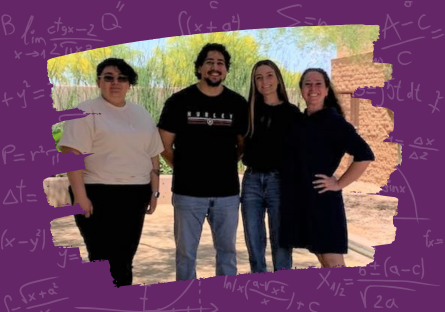

Estrella Mountain Community College Students Win Cash Prize at STEM Challenge Competition
When three Estrella Mountain Community College (EMCC) students signed up to participate in the American Mathematical Association of Two-Year Colleges (AMATYC) Student Research League last March, they had no idea they would be competing for cash awards. Needless to say, they were all pleasantly surprised when AMATYC officials contacted them in October to tell them that they had been named best in the state and would each be getting a check for $200.
“It appears that just doing the math actually paid off!” their mentor, EMCC Math Professor Sara Meana, said with a laugh. “Neither the students, nor I, knew of the potential for a cash prize!”
The AMATYC Student Research League is a partnership between two-year college students and faculty mentors who are seeking STEM knowledge through an AMATYC-approved research program. Each college’s team of one to three math students attempts to solve a STEM Challenge Problem in 18 days with no faculty support to complete the task. This year’s challenge assigned by the League was to use mathematical modeling to design a program or initiative addressing food insecurity among students in low-income communities.
“There was a lot of brainstorming on which topic to pick specifically,” EMCC student Adrianna Ormsby said. “We discussed food assistance programs and free school lunches in low-income areas. But then we thought about college students who might be on their own for the first time, who might be paying for college out of pocket — do they have the funds to keep themselves fed properly? So we ultimately decided to pick one closer to home: food insecurity among college students.”
Adrianna and her teammates, Olive Campbell and Noe Gonzalez, then got to work researching the topic and found that a staggering 29% of community college students struggle with food insecurity.
“That number was quite shocking to us,” Adrianna said. “I started to think about my friends who are on their own at other colleges or universities and them sharing their grievances about not having enough food or the food they could afford having little to no nutritional value. That's when we decided food insecurity among college students, especially within the Maricopa Community Colleges, was going to be our topic, and finding a feasible way to help lessen their burden was our main goal.”
More brainstorming ensued and the team decided to explore the use of hydroponic greenhouse domes. Their model called for three hydroponic greenhouses that would be capable of producing 5,000 pounds of fresh organic produce per year for EMCC’s approximately 2,700 students who struggle with food insecurity. They calculated that it would take about three months to begin producing and nine months to be fully operational.
“Looking into the science of hydroponics was interesting,” Adrianna said. “We had to calculate how much food, namely fruits and vegetables, we could produce given the area of our dome. We also looked at several different hydroponic systems and greenhouse domes to get an estimated cost of installing one on our own.”
Their model called for the cost of the three greenhouses to be offset by grants and donations. The team used a lot of algebra and geometry to calculate the best use of space and keep the costs as low as possible.
“With our plan, we found many donation organizations and community grants that we would use for the first set of greenhouses,” Olive said. “We devised a plan to keep the greenhouse functional with minimal cost and maximum space used by relying on energy-efficient tools, students studying agriculture and engineering, and our own math skills.”
Aside from the cash award and prestige of winning, Olive said the biggest benefit of participating in the STEM Challenge Problem was learning to believe in her ability to do something daunting.
“I love math,” she said. “A big part of my love for math started with Professor Meana — the environment she created in the classroom for the precalculus class I took with her was amazing.”
Even so, she admits she still struggles to understand math and has to put in the work.
“So this challenge proved to me that the extra time I put into my classes and working with my teachers and peers was worth every bit of it,” she said. “Not only did I feel like my hard work was rewarded, but I also grew closer to my peers and teachers through this competition. It gives you a community that you trust and look up to.”
If you are an EMCC student struggling with food insecurity, please access our Student Food Pantry or our Community Garden. You can also contact Student Life to find additional community resources.
If you need assistance conquering your math classes, reach out to the Academic Success Center/Tutoring.